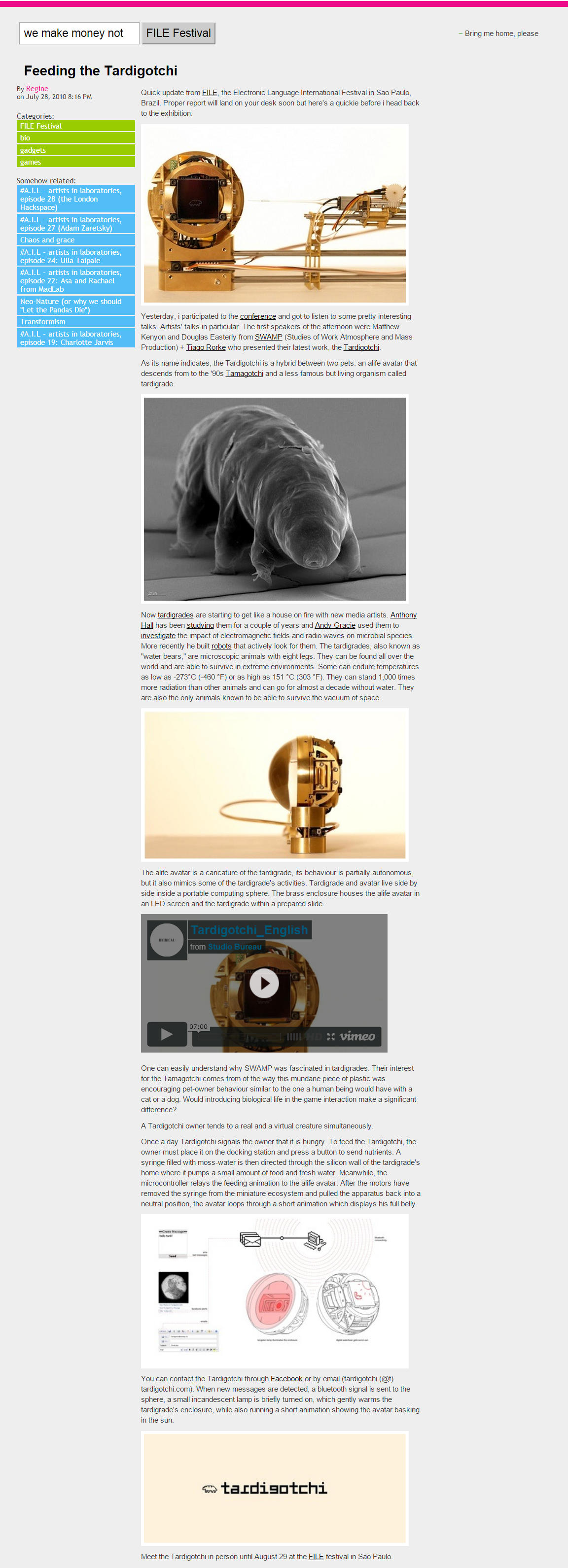
FILE SÃO PAULO 2010
Feeding the Tardigotchi
Quick update from FILE, the Electronic Language International Festival in Sao Paulo, Brazil. Proper report will land on your desk soon but here’s a quickie before i head back to the exhibition.
Yesterday, i participated to the conference and got to listen to some pretty interesting talks. Artists’ talks in particular. The first speakers of the afternoon were Matthew Kenyon and Douglas Easterly from SWAMP (Studies of Work Atmosphere and Mass Production) + Tiago Rorke who presented their latest work, the Tardigotchi.
As its name indicates, the Tardigotchi is a hybrid between two pets: an alife avatar that descends from to the ’90s Tamagotchi and a less famous but living organism called tardigrade.
Now tardigrades are starting to get like a house on fire with new media artists. Anthony Hall has been studying them for a couple of years and Andy Gracie used them to investigate the impact of electromagnetic fields and radio waves on microbial species. More recently he built robots that actively look for them. The tardigrades, also known as “water bears,” are microscopic animals with eight legs. They can be found all over the world and are able to survive in extreme environments. Some can endure temperatures as low as -273°C (-460 °F) or as high as 151 °C (303 °F). They can stand 1,000 times more radiation than other animals and can go for almost a decade without water. They are also the only animals known to be able to survive the vacuum of space.
The alife avatar is a caricature of the tardigrade, its behaviour is partially autonomous, but it also mimics some of the tardigrade’s activities. Tardigrade and avatar live side by side inside a portable computing sphere. The brass enclosure houses the alife avatar in an LED screen and the tardigrade within a prepared slide.
One can easily understand why SWAMP was fascinated in tardigrades. Their interest for the Tamagotchi comes from of the way this mundane piece of plastic was encouraging pet-owner behaviour similar to the one a human being would have with a cat or a dog. Would introducing biological life in the game interaction make a significant difference?
A Tardigotchi owner tends to a real and a virtual creature simultaneously.
Once a day Tardigotchi signals the owner that it is hungry. To feed the Tardigotchi, the owner must place it on the docking station and press a button to send nutrients. A syringe filled with moss-water is then directed through the silicon wall of the tardigrade’s home where it pumps a small amount of food and fresh water. Meanwhile, the microcontroller relays the feeding animation to the alife avatar. After the motors have removed the syringe from the miniature ecosystem and pulled the apparatus back into a neutral position, the avatar loops through a short animation which displays his full belly.
You can contact the Tardigotchi through Facebook or by email (tardigotchi (@t) tardigotchi.com). When new messages are detected, a bluetooth signal is sent to the sphere, a small incandescent lamp is briefly turned on, which gently warms the tardigrade’s enclosure, while also running a short animation showing the avatar basking in the sun.
Meet the Tardigotchi in person until August 29 at the FILE festival in Sao Paulo.